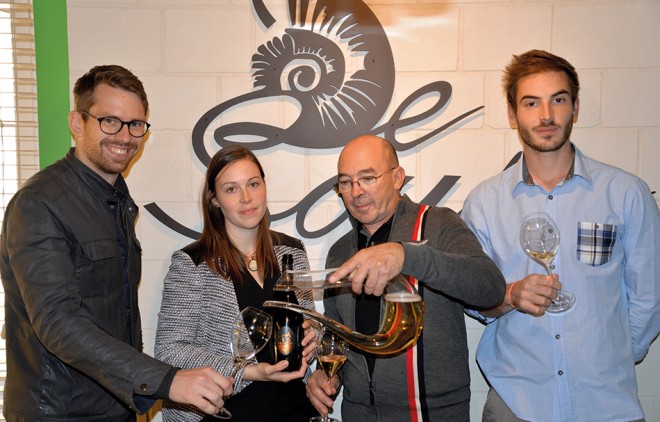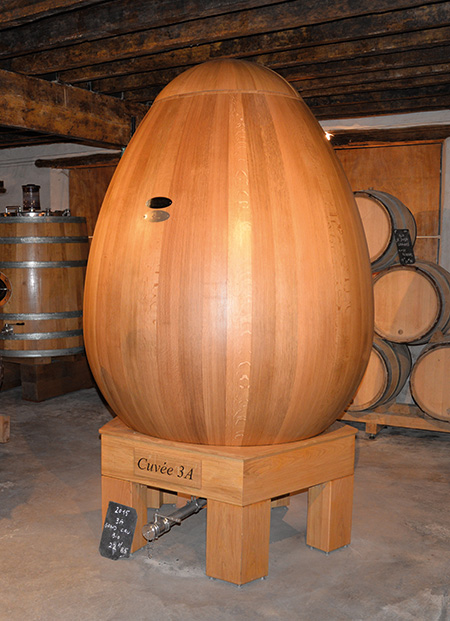For Erick De Sousa, head of the De Sousa family and Champagnes, winemaking is not just a profession. It is a dedication, almost a religious calling. His wines are the expression of that passion.

Erick welcomes Arvid Rosengren, the World Best Sommelier 2016, in his cellar, by the “egg” that sits majestically in its center. It is actually a large wine cask, shaped like an egg, and it is filled up with the « 3A » cuvée. It has been designed and built by four talented carpenters officially distinguished as Best Craftsmen of France. The iron circles that one can see holding a barrel together are here absent, replaced by iron wires, that have been inserted in the wood and are therefore invisible both from outside and from inside. More than a simple barrel, it is a work of art that illustrates the De Sousa holistic approach to wine and winemaking. As Erick De Sousa has been working in biodynamics for the past twenty years. “I wanted to give back to the soil what it has given me over the years. Without the soil of Champagne our domain would not exist.”
De Sousa Champagnes are made without any chemical additive, and without using any herbicide or pesticide, but instead with natural treatments applied according to the lunar calendar and designed to channel energy into the vine.
“De Sousa Champagne is a family business, says Erick. We seek authenticity in our wine. We want them to carry emotions, display the specific minerality of the Champagne soil, have great depth and a long finish … We produce nearly ten cuvées, among which the Caudalies Cuvées, the 3A cuvée, Umami and Mycorhize, as well as a bled rosé. And we are going to taste them all …”
After a light introduction, Erick opens the Umami 2009 cuvée. “The Umami cuvée was born from a trip to Japan where I personally discovered the existence of this ‘fifth taste’. Right away I tried to create a Champagne that would replicate that taste. Umami is therefore a style of Champagne. It does not follow a terroir approach. It requires a warm year, very ripe grapes, barrel fermentation with stirring of the lees, and malolactic fermentation. The goal is to produce still wines that are very round and will make the Champagne savory and onctuous.”
To underline the contrast, Erick next opens a bottle of the Mychorize cuvée. The name derives from the micro-organisms that live in symbiosis with the roots of the vine. The more the soils contains such living organisms, the healthier the vine will be and the better the grapes. The cuvée is elaborated from Grand Cru plots planted with Chardonnay, using biodynamic agriculture and horse drawn ploughs since 1999. “Mycorhize is the exact opposite of Umami, says Erick De Sousa. It is the purest expression of old vines from Avize. This cuvée requires the winemaker to step back and intervene very little.” Arvid Rosengren confesses to being impressed by the results. He finds the wine to be “fantastic and better than anything so far”. He enjoys the “terroir minded approach” and is really astonished. “The wine is magnificent, delicate on the nose, yet intense on the palate, with a complex finish and chalky tension.”

The 3A cuvée is a blend of 50% Pinot Noir and 50% Chardonnay whose grapes come from the three grand cru villages whose name start with an ‘A’: Ambonnay and Ay for the Pinot; Avize for the Chardonnay. It’s an extra-brut, but the wine displays nice pastry notes.
The next bottle is a ‘Cuvée des Caudalies Grand Cru 2008’. Erick decides to decant it because he says “2008 is one the best vintages of the past thirty years, along with 2002 and 1998”. The Caudalies range was created in 1995 when Erick decided he should produce a “prestige cuvée”. “We wanted to produce a wine with a long finish and the name we picked reflects our ambition”, he says. Since that day, reserve wines destined to be integrated into the Caudalies cuvées have been put in a ‘perpetual reserve’ that contains every single vintage since 1995. The wine is elaborated from 100% Chardonnay old vines, it is vinified and matured for ten months in oak barrels with frequent lees stirring. This one was disgorged in 2015. Arvid Rosengren finds the wine charming and admits to being “short of the proper words to convey all the richness and complexity of the wine, which is at once homogenous and very hard to break down. It has plenty of time and decanting it, really helped.”
Finally Erick brings out his ‘Rosé de Saignée 2013’, with a dosage of 7 gr. Only 700 bottles have been produced. The robe is fuchsia, and its first nose a bit wild. It takes a bit of oxygenation for it to release its fruity aromas. Arvid Rosengren finds the wine “fairly interesting”. “From the robe one might expect the wine to be sweet, but it tastes like a good Pinot Noir, almost like a red Burgundy with bubbles.”
When asked about his overall impression, Arvid stresses that “it is difficult to sum it up because there are so many different cuvees. It is even difficult to talk of a house style, but the tasting revealed some very original and definitely interesting wines. This was really a quality tasting,” he says.
Gérald Olivier